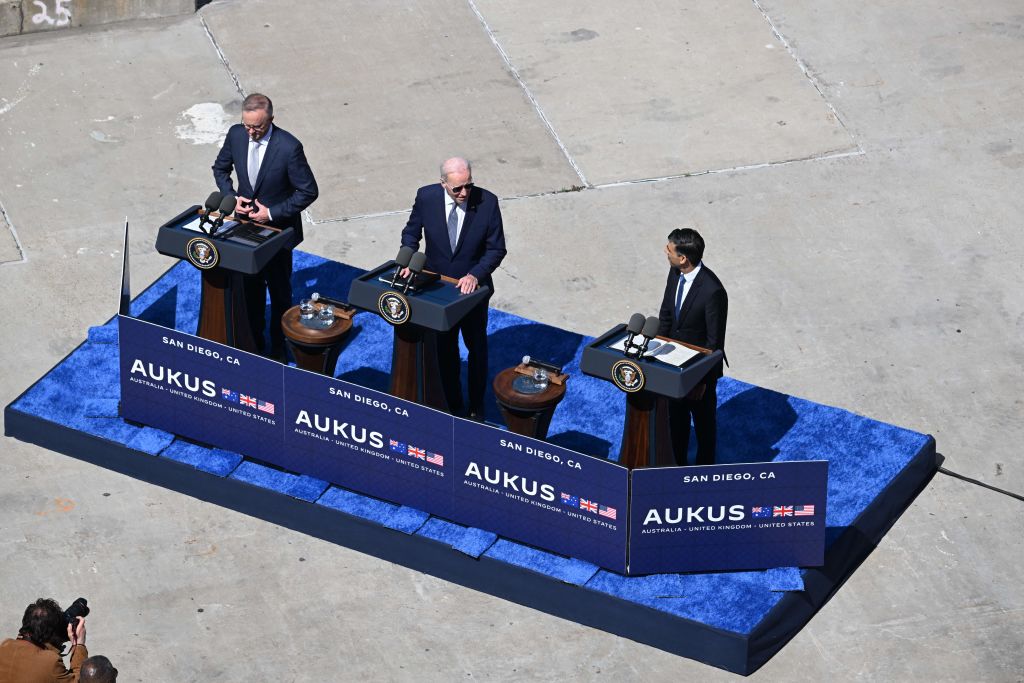
At think tank gatherings over the past few months in Washington, I asked foreign and security policy analysts about their thoughts on AUKUS. In the ensuing exchanges, US analysts raised three consistent sources of uncertainty that demonstrate how important it is to hear conversations across the US states that will take the lead on delivering AUKUS.
State and local politics, mixed with tax, economics and incentives, will affect the efficacy of the AUKUS agreement between Washington, London and Canberra. After all, Australia’s Virginia-class nuclear-powered attack submarines will be built in American states, not the District of Columbia, and will involve a vast network of defence suppliers, manufacturers and technologies. Engaging these stakeholders early and often is imperative for the pact’s success.
For the Americans, AUKUS is a natural extension of the ANZUS alliance and the Five Eyes intelligence-sharing network. Australia’s distinction of fighting alongside the US in every major conflict over the past century is not lost on them, and the assumption that Canberra would commit the Australian Defence Force to a potential war with China over Taiwan is common. In some discussions, Australia’s sovereignty was acknowledged, but it is not considered sacrosanct.
The question of sovereignty, then, was the first area of uncertainty. Because of the power imbalance between the US and Australia, some American analysts view Australia’s sovereignty as ‘relative and negotiable’ when it comes to safeguarding American strategic interests in the Indo-Pacific. Although the American-built Virginia-class submarines will fly the Royal Australian Navy flag and be under Canberra’s command, American analysts tend to believe that Washington would have sway, if not a veto, over the Australian government’s use of them. Understood that way, AUKUS could erode Australia’s manoeuvrability and sovereignty if the alliance doesn’t establish strong guardrails to protect them.
While these sentiments aren’t usually explicit, Australia needs to be aware of the strong expectation that it would join the US if a conflict broke out. This position was captured in a statement in July 2022 by the chair of the Joint Chiefs of Staff, Mark Milley, who expressed full confidence that ‘if something occurred in the future, then Australia and the United States would still be shoulder to shoulder.’
The second area of uncertainty was the ability of AUKUS to achieve the strategy’s stated purpose of deterring China. Exactly how AUKUS will deter China is a work in progress and an unknown. It will be at least 10 years before Australia’s first Virginia-class boat hits the water, and at least 20 before the new class of AUKUS submarines is launched.
While they’re lethal today, it’s hard to know how effective nuclear attack submarines will be in 20 years. Can AUKUS’s submarine element stay ahead of the technological curve? There’s no clear answer to that question. The AUKUS partners must simply innovate, incorporate and deploy the best capabilities they can while maintaining the hope that their relative technological lead holds for long enough to become a robust military posture that deters China. Canberra, London and Washington must provide a reasoned calculus of how AUKUS would stabilise the region and deter China without leading to greater instability or militarisation.
The third concern was the hefty price tag. Australian Treasurer Jim Chalmers said the AUKUS decision was a ‘game-changing investment,’ and the government has assured the public that aside from nuclear weapons, AUKUS is the only way to maintain Australia’s non-proliferation commitments while safeguarding its vast size and maritime domain. But with the submarines costing up to $368 billion, it’s unclear whether, and for how long, future Australian governments will continue funding an unfinished capability. Defence deals are notorious for cost blowouts, so Australian taxpayers should be prepared to fund AUKUS beyond the quarter-trillion-dollar mark, and renegotiations and cancellations are common.
Yes, AUKUS will enable Australia to inflict costs on an adversary much farther from its shores, and AUKUS’s Pillar 2—which involves cooperation on advanced capabilities such as artificial intelligence, quantum technology, hypersonic weapons, cybersecurity—is likely to come online sooner and help deter China until Pillar 1 (the submarines) can be finished. But Australia must acknowledge that despite being the smallest AUKUS partner, it’s expected to have the deepest pockets since it is arguably also its biggest beneficiary. Australia is geographically nearer China, relies on the US for its extended nuclear deterrence, and will suffer a capability gap when its fleet of conventionally powered Collins-class submarines is phased out.
We won’t know for some time whether AUKUS can achieve its stated objective of deterring China. After all, deterrence is successful until it isn’t. But as China asserts itself more and more, it may become more confident that it will get its way. The status quo in the Indo-Pacific will come under increasing stress. AUKUS is designed to balance against this and protect the region’s US-led security architecture. Every member of the agreement must be acutely aware of that, because it carries with it the immutable expectation of Washington that its allies in the Indo-Pacific will deliver.

